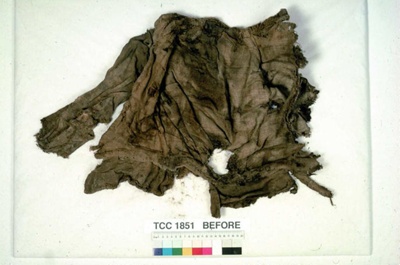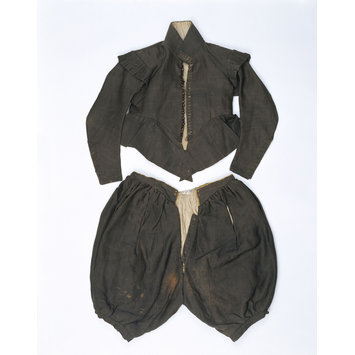Two of these happen to be linen doublets. The Reigate doublet was detailed in a thesis by Susan Stanton in 1995, so we know it consists of three layers of linen in the body with additional layers of stiffening around the collar and only two layers of linen for the sleeves and skirts. The buttons are linen cord wrapped around a solid core (presumed to be wood). It has a bound edge around the neck and piping several seams. It is difficult to tell if there was top stitching of seams or not.
The Alspirbach doublet is intact, and described as linen lined with a coarser linen. We don't know if there are additional layers internally. From the few pictures available, it has no top stitching on the skirts. The neck has a small binding and the center front is either top stitched or has a very small binding. There are no buttons, but there are two eyelits at the neck and one or two eyelits at the waist.
Another example of a simple doublet comes from the V&A. This doublet is made of plain wool serge and lined in a linen (with a pile). The museum does not mention if there is any interlining or stiffening. A close up shows that the buttons are worked. The pictures are not detailed enough to see any top stitching.
Next we have a doublet and hose from Germany (LM-2396.1-7). There is not much detail about it available. It seems to made of wool. There is top stitching around the skirts, center front and on the arm wings. There are buttons, but the pictures are not detailed enough to show if they are worked or cast.
Another that I consider basic is the Nils Sture leather doublet. From Lena Rangstrom's description in Lions of Fashion and some additional close up pictures, it's clear that the leather was sewn as a fabric. There is top stitching and piping around the neck. She also describes additional stiffening in the collar, but there is no mention of interlining. The doublet had small silver buttons. While simple in decoration, we know that the owner of this doublet was very much upper class, so it is not a great example of an every day doublet, but it does illustrate what a basic traveling doublet for the wealthy was like.
I recently came across another, known as the Abingdon doublet. It is another concealed find, in rough condition. It is made of wool and lined in linen. Arnold dated it to 1620-1625. It has an interlining and the collar is stiffened with paper/cardboard. The buttons are chevron over a solid (likely wood) core.
So, even for basic clothes made for young boys or orphans, we see typical construction. The proof for interlining is inconsistent, but extra stiffening at the neck seems common.
Top stitching was common but not consistent across this sample.
If we discount the silver Sture buttons, we see a few examples of worked buttons over what's likely a wooden core. I really thought I might see a more basic (not as decorative) form of button on an every day doublet, but I have proven my own theory incorrect.
I will mention that one of the other linen doublets that is highly embroidered has buttons of "rolled rag" with button hole stitched worked over. This is the only example of cloth buttons I have been able to document to this time period.










No comments:
Post a Comment